My language learning journey: the past, the present and the future
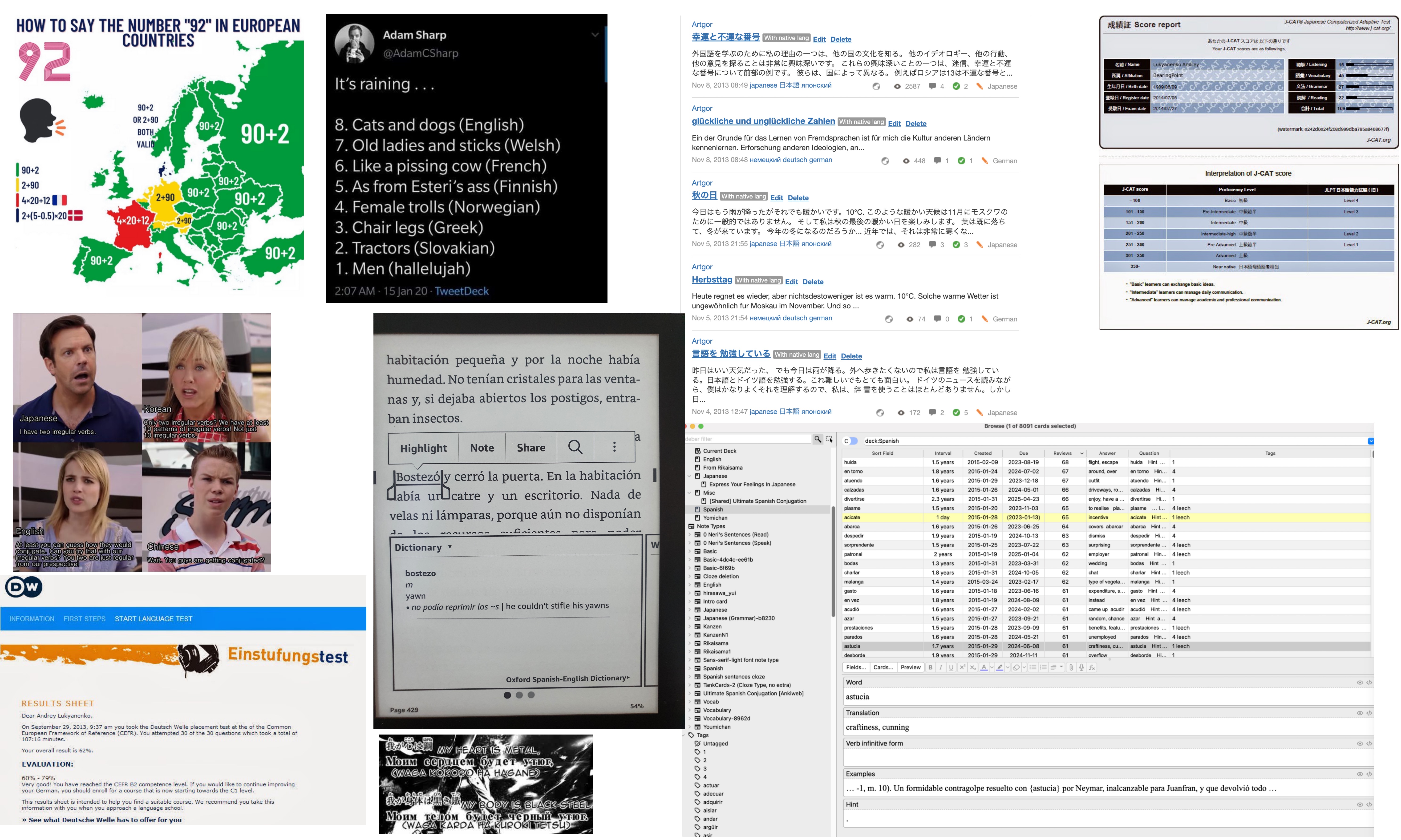
“Languages both permit and oblige to perceive and express the world in a certain way.” © Complete Spanish course by Language Transfer
As the world continues to evolve and change at an increasingly rapid pace, it can be easy to focus solely on technological advancements and forget the importance of human connection. However, it is important to remember that despite all the advancements in communication technology, nothing can replace the personal touch and understanding that comes from speaking to someone in their native language. Learning a foreign language not only allows you to connect with people from different cultures but also helps to break down barriers and build stronger, more meaningful relationships.
When I think back to my days in school and university, I remember feeling like language learning was just a cumbersome subject. However, when I started studying and using foreign languages of my own volition, it became something much more for me. Now language learning has become a hobby that I truly enjoy. Each language opens a window into a new world, revealing different cultures, ways of thinking, and ways of expressing yourself. Learning languages feels amazing and fills me with a sense of wonder.
Speaking about my knowledge of languages: Russian is my native language, I speak English fluently, in 2013 I reached B2 in German (but now I regressed), got to ~N3 in Japanese in 2014 (but regressed too), and recently I reached B2 in Spanish.
In this blog post, I want to share my experience of studying different languages, describe how my approach evolved over time, and give advice on studying more efficiently.
On the differences between the languages
When I was studying Japanese and reading manga, I came across this page with the text in Japanese, English, and Russian. This is a moment when the hero is chanting some cool spell. The English translation is good, but the Russian one is just abysmal.

我が心は鋼 - it means something like “my heart is steel”, the English translation is “my heart is metal”, which is close. But the Russian translation is “моим сердцем будет утюг”, which can be translated as “my heart will be iron (flatiron)”. I suppose that 鋼 could be roughly translated as steel/metal/iron and then someone saw the word “iron”, decided that it meant “flatiron”, and that’s why we got “утюг”.
This was definitely a fan translation (or maybe it was some kind of joke?) and no good translator would make such a mistake, but, nevertheless, any translated text will have some degree of misunderstanding, voluntary interpretations, and other changes.
One key thing to remember is that translating a sentence into a different language doesn’t mean just splitting it up into individual words, translating them, and then putting them back together. The grammar and sentence structure can be vastly different, and sometimes the translated text may need to have its word order adjusted or be more concise or verbose.
Even if the translator did an excellent job, a lot could be lost in translation. Listening to or reading native materials can give you a very different understanding of the text.
When you start thinking, speaking, and writing in another language, you realize that other languages aren’t just different words - they provide different ways of thinking and perceiving the world.
Here are some examples:
- There are terms and concepts that are unique for specific languages. In fact, there is a subreddit dedicated to this.
- Some languages have specific symbols:
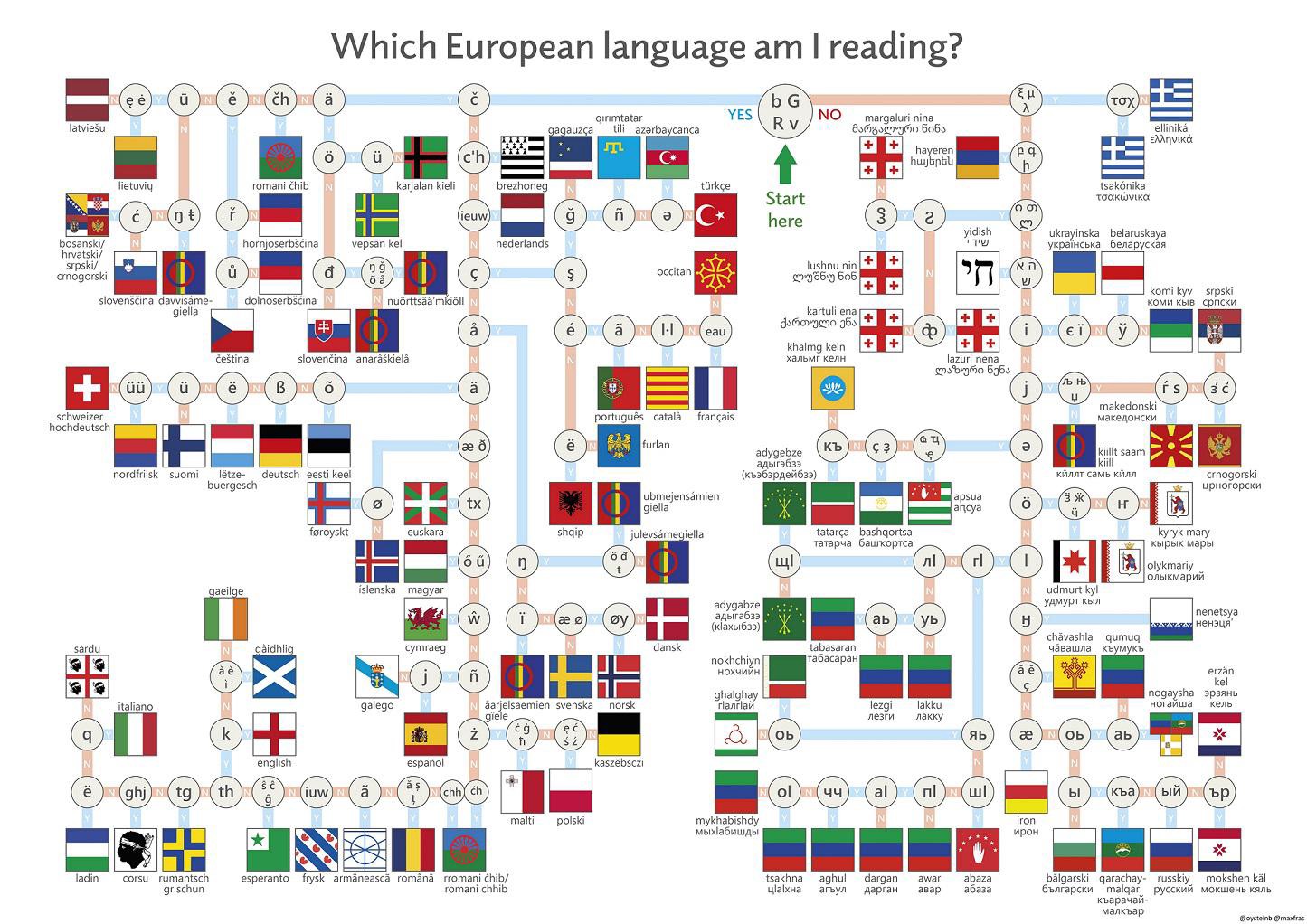
- And, of course, there are hieroglyphical languages:
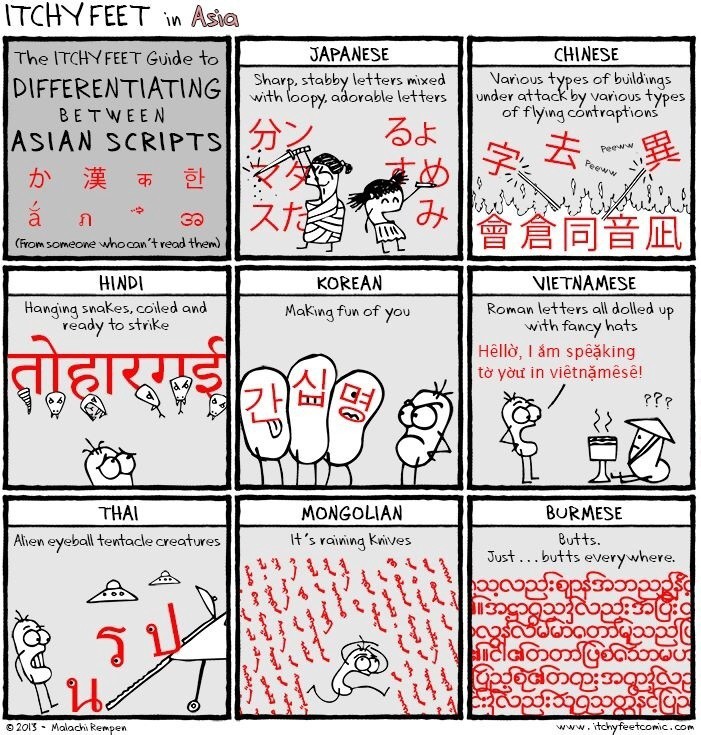
- Some languages have a strict word order and use affixes, prepositions, and other ways to show dependencies between the words. Some languages use word order to convey a different meaning or change an emphasis;
- Asian languages have a complex system of honorifics; *Consistent vs. inconsistent pronunciation. For example, in Spanish, in most cases, you can understand the pronunciation when you see the word, but in English, it can vary easily;
- Some languages don’t distinguish genders in pronouns;
- Counting and numbers can be very different. For example, in Japan, the basis of counting big numbers is 10000 (万), not 1000 like in western countries.
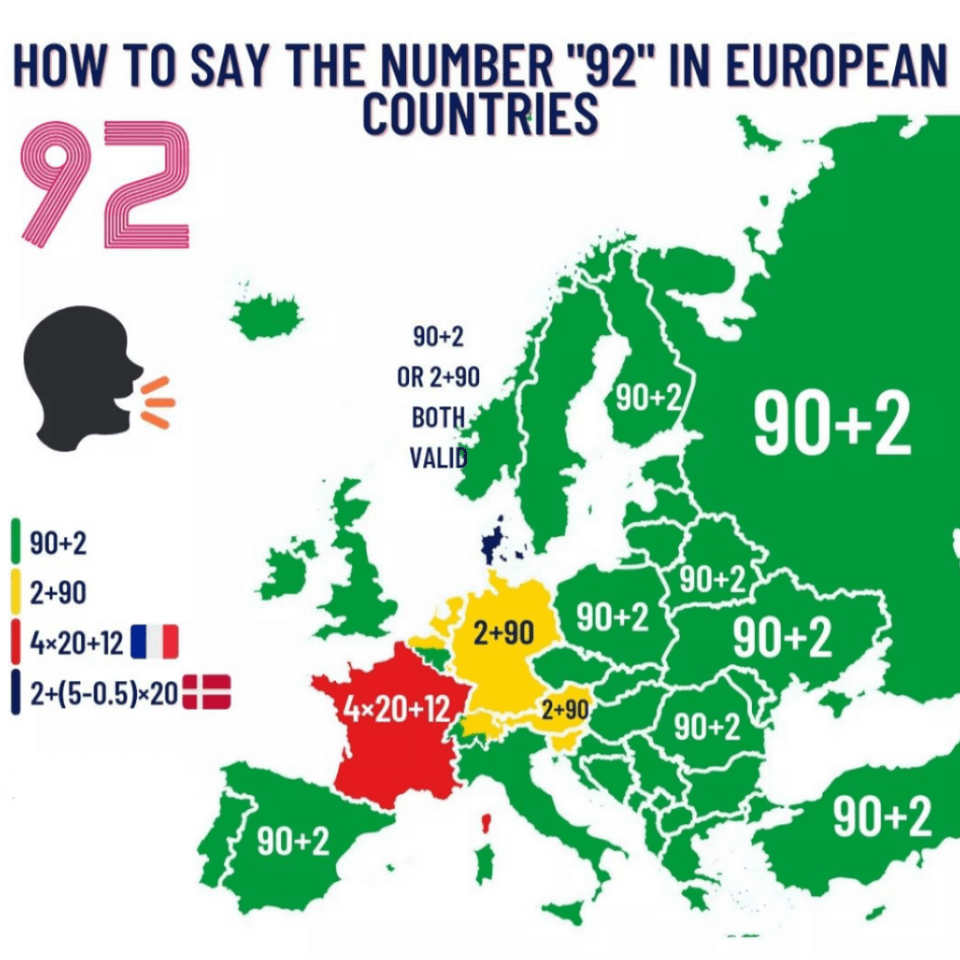
- The same idiom can be something completely different in another language.

ah, subtle poetry of some languages
There are myriads of other differences, of course, it is impossible to mention all of them.
My journey of studying foreign languages
English
English is a language that is taught in most schools in Russia, and for me, it was no exception.
In the early years of school, my English lessons were nothing short of terrible. I still remember the way we were taught pronunciation in the beginning classes. For example, the word “knight” is pronounced /nʌɪt/, but we were taught to pronounce each letter individually, which resulted in it sounding like /kniːɡht/. It’s funny to think about now, but at the time, it was just confusing. As I moved on to later classes, the quality of the English lessons improved, but there were still some issues - like a strict teacher who would randomly stop teaching and tell stories (in Russian) for half the lesson.
I also studied English for two years in university, but it was mostly about economics, and I don’t remember much about it.
In addition to school and university, my mother also hired private tutors to help me improve my English. Some of them were decent, but others were plain awful. One of them, for example, made me memorize the entire table of irregular verbs and their conjugations by heart and didn’t teach me anything else until I could recite them from memory. It was boring and time-consuming, and she would shout at me whenever I made a mistake. It was an unpleasant experience, but I have to admit, it was effective - I learned all of them, and for many years I could reproduce the table. But I’m sure there are better ways to learn verb conjugations without making the experience so unpleasant.

I had been studying the language for several years, but despite having a solid foundation built by an awesome private tutor who helped me with grammar, speaking practice, and watching videos with native speakers, I still couldn’t use English well. Even after more than five years of studying, it was difficult for me to read books or speak in class, despite being more advanced than many of my classmates.
I remember trying to read an Agatha Christie book in my last classes of school, and it was quite difficult for me.
The reason for my ineptitude was a complete lack of practice outside of studying.
So, I decided to change that. It was the summer of 2007, and my mother bought me “Harry Potter and the Deathly Hallows”. I wanted to approach studying “correctly” by writing down every unknown word and looking them up in a dictionary. After reading a couple of chapters, I looked down and saw a list of tens of unknown words. I started translating them, but the process was excruciatingly slow. I eventually closed my notebook and just continued reading. At first, it was slow, and I struggled to keep pace with the sheer volume of unfamiliar words and phrases, but by the end of the book, I understood around two-thirds of the text. This success encouraged me, and I immersed myself in English content.
I read “A Song of Ice and Fire” (wow, now that I think about it, at that point four of the five currently published books were available), then watched all the series of “Xena: Warrior Princess” and “Hercules: The Legendary Journeys” with English subtitles. I don’t remember all the books I read after that point, but I think that only since 2014 have I started reading much more: Dresden Files, Chronicles of Amber, Cosmere series by Brandon Sanderson, and many other books.
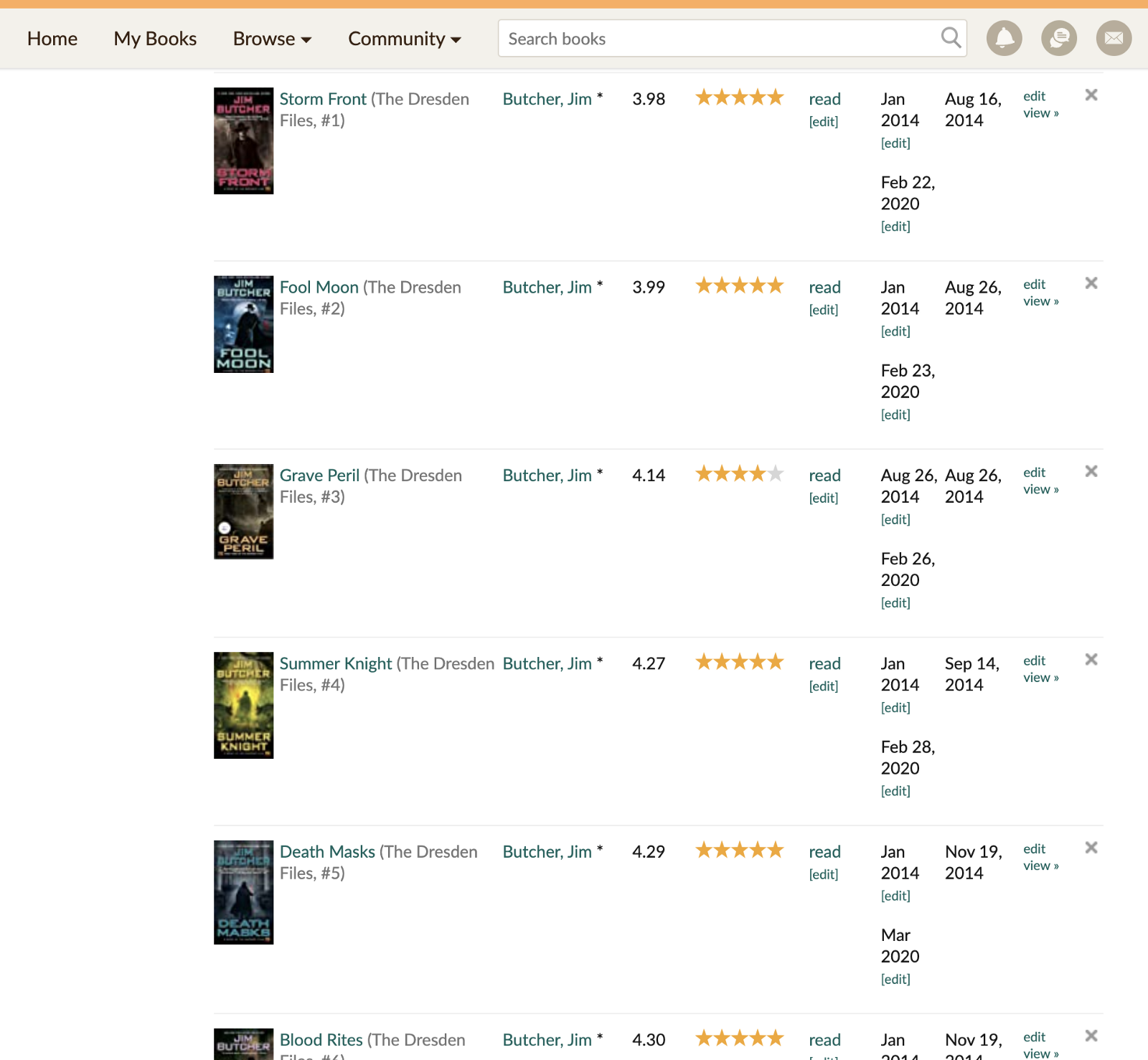
In 2013–2016, I had the opportunity to work on a project where English was the official language, a rarity in my home country of Russia. While discussions with my Russian colleagues were conducted in our native language, all documents and meetings with foreign colleagues were conducted in English. At first, this presented a challenge, particularly due to the poor quality of some calls. However, as time passed, I grew accustomed to this mode of communication and even had the opportunity to travel to Geneva to train others in the use of our software and give a pre-sale presentation on another occasion.
I remember sitting in the Geneva office and speaking with an American and a British person at the same time. They had very different speaking styles - one was slow and methodical, while the other was fast-paced and at times, hard to understand. But despite these differences, we had a productive discussion, and it really improved my confidence and reduced my worries about my accent.
In 2016, I made the switch to data science. There were far more materials in English than in Russian, so I had to use them a lot. In a couple of years, I was even giving professional talks, which helped my English even more.
One particularly interesting experience I had was in 2021 when I had an interview with a company where the first round was a talk with a teacher of English to evaluate my level. I was surprised by this, as I had never encountered such a requirement in any other company before or after. The teacher noted that while I could fluently speak on any necessary topic, I sometimes used past simple instead of present perfect or vice versa and that I had a problem with final devoicing and pronouncing certain words incorrectly. As a result, I was informed that I did not pass the evaluation. It was a strange experience, and I think these small mistakes could be due to dialectical variations.
On the other hand, in 2022, I moved to Dubai, and several people there complimented me on my proficiency, saying that I spoke fluently.
Traditional approaches like studying in class and using textbooks gave me a solid foundation in English. However, it wasn’t until I began immersing myself in native materials and making the language a part of my daily life that I truly started to master it.
Looking back, I wish I had made this shift in my approach earlier. But better late than never, right? Now, I actively incorporate English into my life through reading and writing in the language more than I do in my native language.

I still make mistakes with grammar points like articles or pronunciation. But, as with any skill, practice makes perfect, and I continue to improve daily.
German
After passing my university exams, I was required to take an additional test to measure my proficiency in English. Those who scored low were required to study English for two years, while the rest of us were given the option to study French or German. And that’s how I found myself starting my German language journey.
My initial experience with German was far from ideal. My class was supposed to be for complete beginners, but our teacher threw us into the deep end from day one. She spoke exclusively in German and expected us to have near-perfect pronunciation from the start.
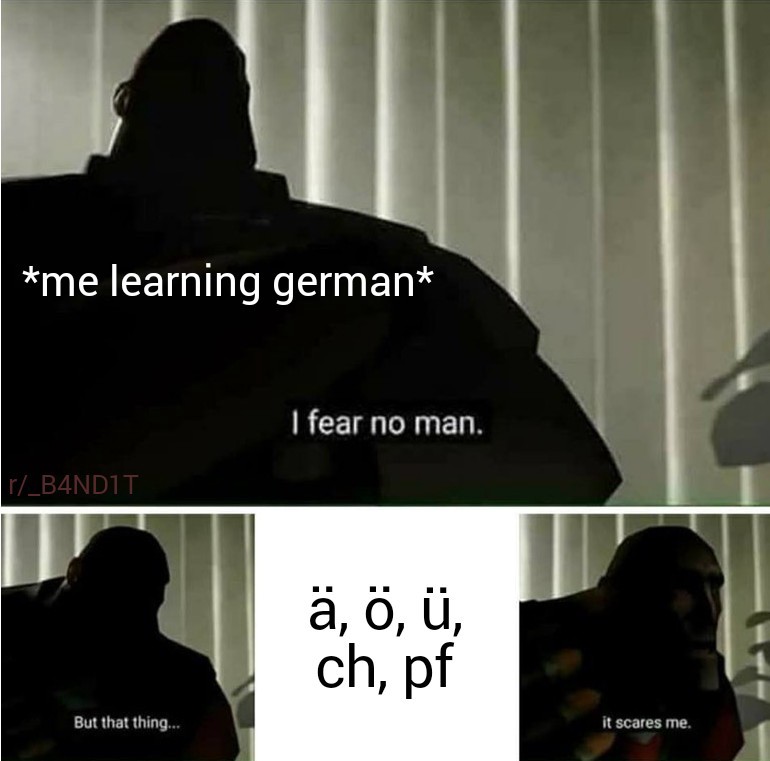
In theory, this approach is great, but in practice, it was an absolute disaster. I still remember my first lesson, where my teacher made me repeat “Athen ist die Kapital von Griechenland” until I pronounced it correctly. If I made any mistakes, she would make me repeat it over and over again without ever explaining what I was doing wrong. She was quick to shout and insult students who made mistakes and even went as far as to kick two students out of class. It was a terrible experience, and I hated every moment of it.
Thankfully, things improved in the second year. Our teacher’s approach and attitude toward teaching changed dramatically, and she became much more understanding and patient. Despite this, I barely passed the exams at the end of the two years.
After that, I didn’t study or practice German for almost five years. It wasn’t until I decided to take a break from studying Japanese that I decided to revisit my German skills. This time, I approached my studies from a different angle, using methods I had learned from studying Japanese.
I joined Duolingo in 2013 to brush up on my basic vocabulary and grammar, and I quickly completed the German tree. At the time, the platform had a great section for translating texts, which I found particularly helpful.

However, as much as Duolingo is a great tool for practicing, it doesn’t provide a comprehensive understanding of grammar.
That’s where “German: An Essential Grammar” by Bruce Donaldson came in. It provided a comprehensive overview of all the grammar points in the German language and helped me fill in the gaps in my knowledge. By combining Duolingo with this grammar book, I was able to refresh my knowledge and improve it significantly.
But the real breakthrough came when I discovered the Listening-Reading method. This method is highly debated in the language-learning community, with some people swearing by it and others denouncing it. I, personally, am a huge fan.
I’ll share more details in the later sections, but the way I used this method was by reading a text in English and listening to it in German simultaneously. This allowed me to expose myself to a lot of content while understanding its meaning. It’s important to note that this method requires full concentration, as you need to be able to read the text faster than the speed of the audio and connect English and German concepts, but the improvement was compounding.
I used this approach to listen in German and read in English four Harry Potter books. When I took the fifth book in German, I was able to understand almost half of the recording without looking at the text. And I achieved this in just two months after I restarted my studies!
In total, I spent about three months on Duolingo, grammar, and listening, as well as reading German news and other activities. Next, I wanted to see how far I had come, so I decided to test my skills.
Not long before that, I discovered the Deutsche Welle website, a fantastic resource for anyone looking to learn German. Not only can you read German news and practice the language, but you can also take a CEFR test to see your level.
My initial attempt was promising, scoring 72% on the B1 level test, but I only received 50% on the B2 level. This indicated that my German was between intermediate and upper intermediate, which was a decent start, but I wanted to aim higher and reach B2.
So, I spent a couple of weeks actively studying. I went through ten lessons on Deutsche Welle for both reading and listening practice, honed my grammar skills in the areas I struggled with before, and wrote several posts on language exchange sites and got them corrected.
And after that, I took the test again and was thrilled to see that I had succeeded. I had reached the B2 level in German!
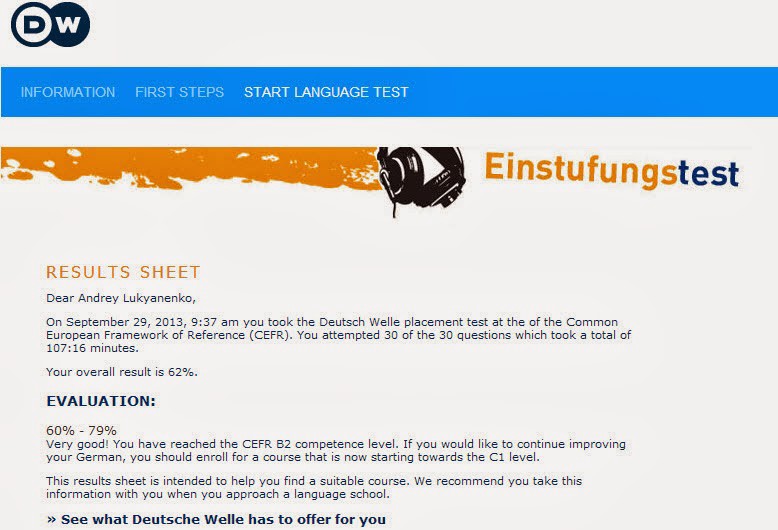
In 2014, the biggest obstacle for me was a lack of motivation. I didn’t know what to do with my German knowledge and was struggling to find something interesting to do with it. That’s when I remembered a series of books about the son of Captain Nemo I read years ago in Russian translation by a German author. These books had captivated me, so I decided to give them another go - this time in German. To my surprise, I discovered that the series consisted of twelve books! As I began reading, I realized that I could comprehend around 70–80% of the text, which I think is a pretty good result. The last book was not available in e-format, so I had to turn to an audiobook. I was really happy that the German audiobook wasn’t difficult for me to understand.
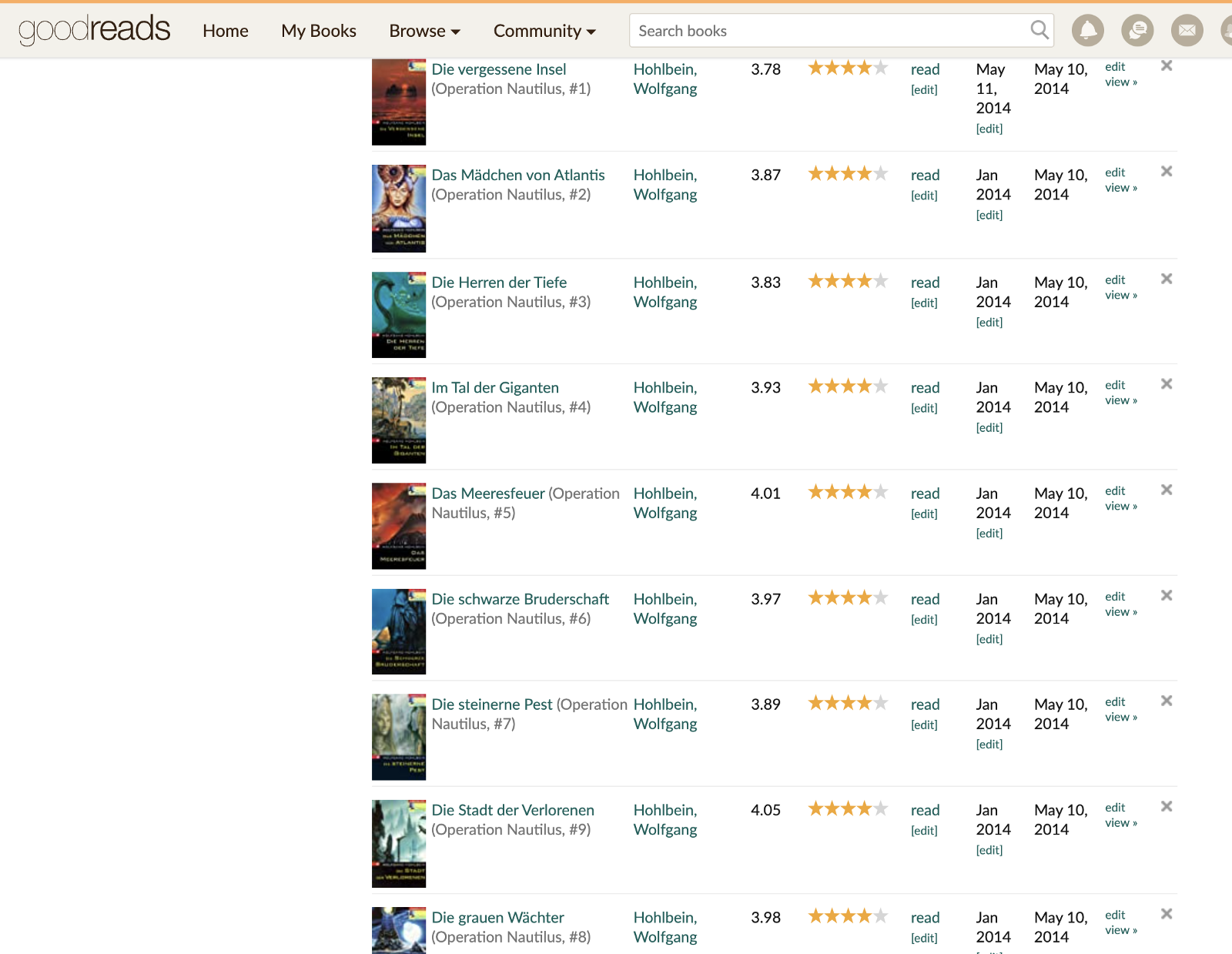
Unfortunately, after this experience, I had to take a break from studying and practicing German as I didn’t have enough time or motivation.
- Learning German through regular classes can be pretty efficient, but it takes more than just that. You gotta have a real interest in the language and put in the effort to practice outside of the classroom;
- If you don’t use a language regularly, you’ll probably forget it in a few years. But with a little focused practice, you can get back on track pretty quickly;
- For me, the listening-reading approach worked wonders;
I’m planning to dive back into German once I feel confident with my Spanish skills.
Japanese
My reasons for studying Japanese weren’t anything special - I wanted to watch anime, read manga and light novels, and play visual novels in the language. But what really pushed me to start learning Japanese in October 2012 was playing the visual novel Eien no Aselia in English. After completing it twice, I realized that the version I had played wasn’t the full game and that the full version hadn’t been translated into English. That’s when my desire to learn Japanese outweighed my laziness and hesitancy, and I began my journey of learning the language. My goal was to be able to play the game in Japanese within a year - ambitious but a great motivator.

This was my first experience teaching myself a language without any formal education. I made some mistakes along the way and didn’t always focus on the important stuff, but it was fun and rewarding.
I started off learning katakana and hiragana. I studied the symbols and wrote them down on a piece of paper every day. It took me almost a month since I couldn’t dedicate a lot of time each day, but I eventually got it.
Then came the daunting task of learning kanji. But thankfully, I found “Remembering the Kanji” by James W. Heisig, and it really saved me!
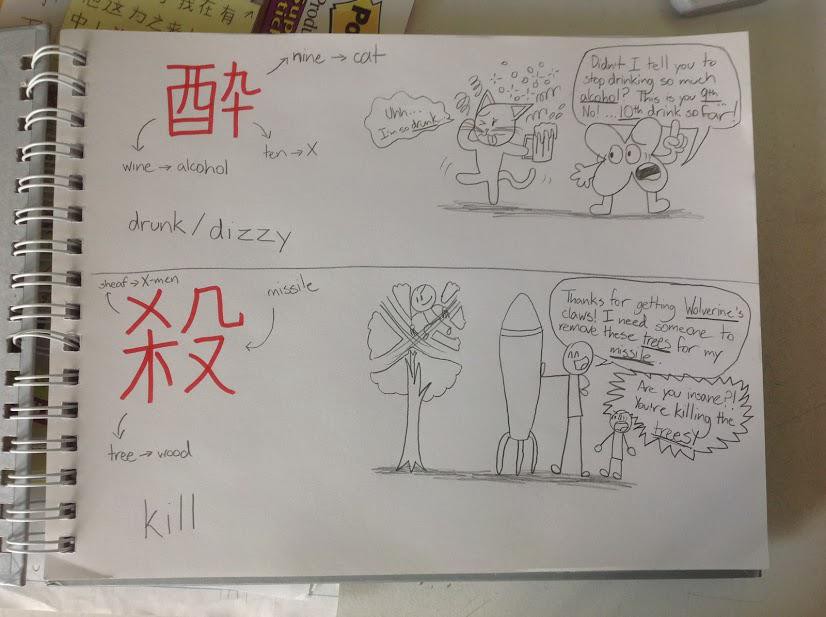
There are various ways to learn Kanji, including:
- Writing them out with pencil or pen, repeating as you learn;
- Breaking them down to radicals and learning Kanji as a combination of the primitives;
- Learning Kanji with associated vocab;
- Remembering the Kanji (RtK), a method developed by James Heisig. It uses keywords made up of radicals called “primitives” and mnemonic stories are constructed to remember the Kanji meaning. As the learner becomes more familiar, the goal is to recognize Kanji meaning and be able to write it, eventually no longer needing the mnemonic;
- The Kodansha Kanji Learner’s Course uses building blocks and sample compounds comprised of previously learned Kanji. Each Kanji is annotated with mnemonics and tips such as remembering readings and distinguishing between similar Kanji. It can be reviewed with Memrise. Some call this approach a modernized RtK;
- Various apps like WaniKani;
- etc.
I chose RtK because I liked the idea. It teaches 2042 Kanji (3030 in the full version).
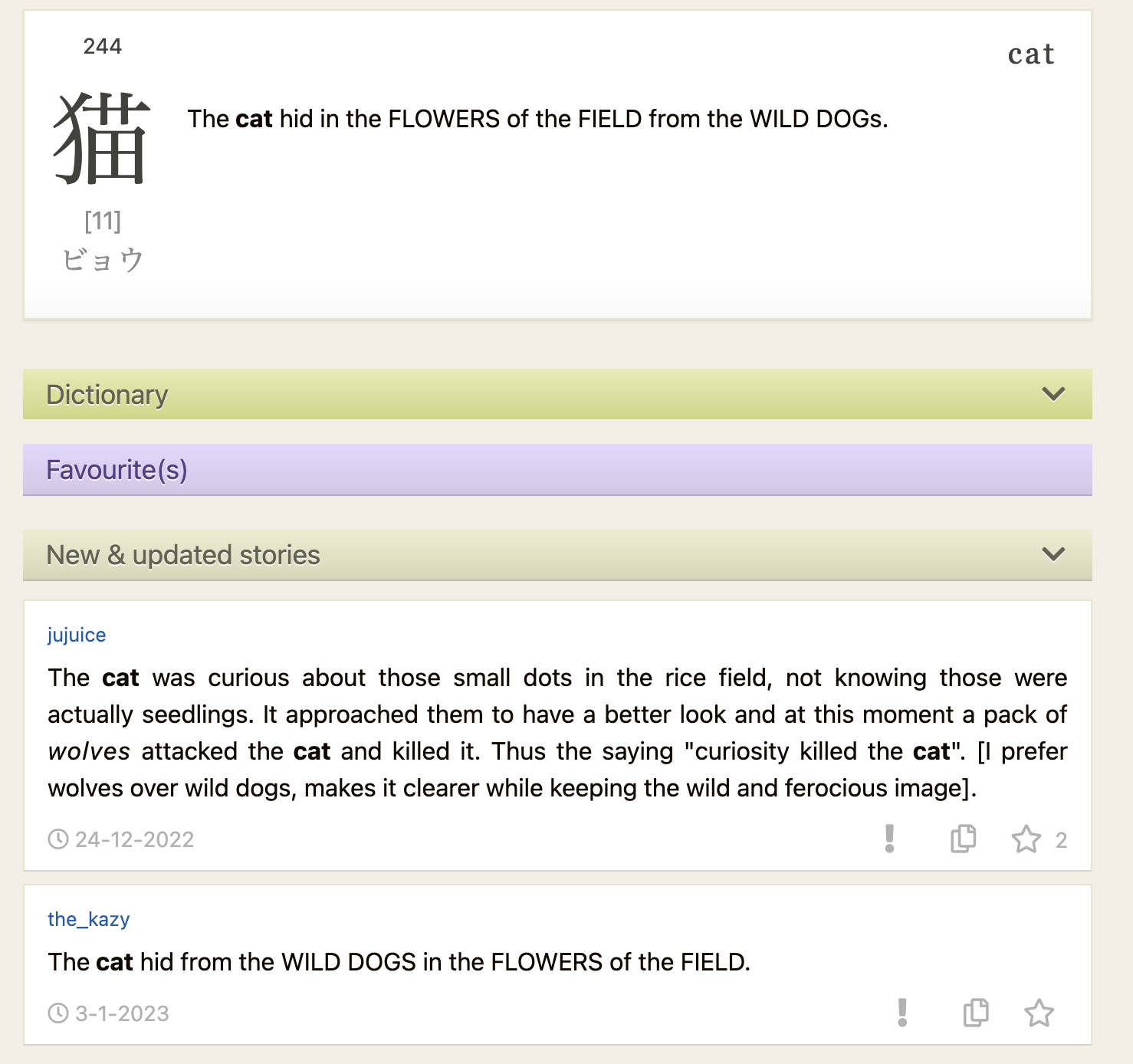
As I mentioned before, the idea is to create mnemonics. We split up each hieroglyph into its individual symbols and use them to create a story. For example, the kanji itself means “cat”, the left symbol is “a pack of dogs/wolves”, the top symbol is “a flower”, and the lower one is “a field”. We can then use these symbols to create a story - “The cat hid in the FLOWERS of the FIELD from the WILD DOGs.”
Does that sound complicated? It might, but it gets easier the more you do it!
But just learning isn’t enough. You need to keep repeating the kanji if you want to remember it. Space repetitions help with it. The best way to do this is to make flashcards with a question on one side and an answer on the other. Then you can go through them each day to get the information to stick in your head.
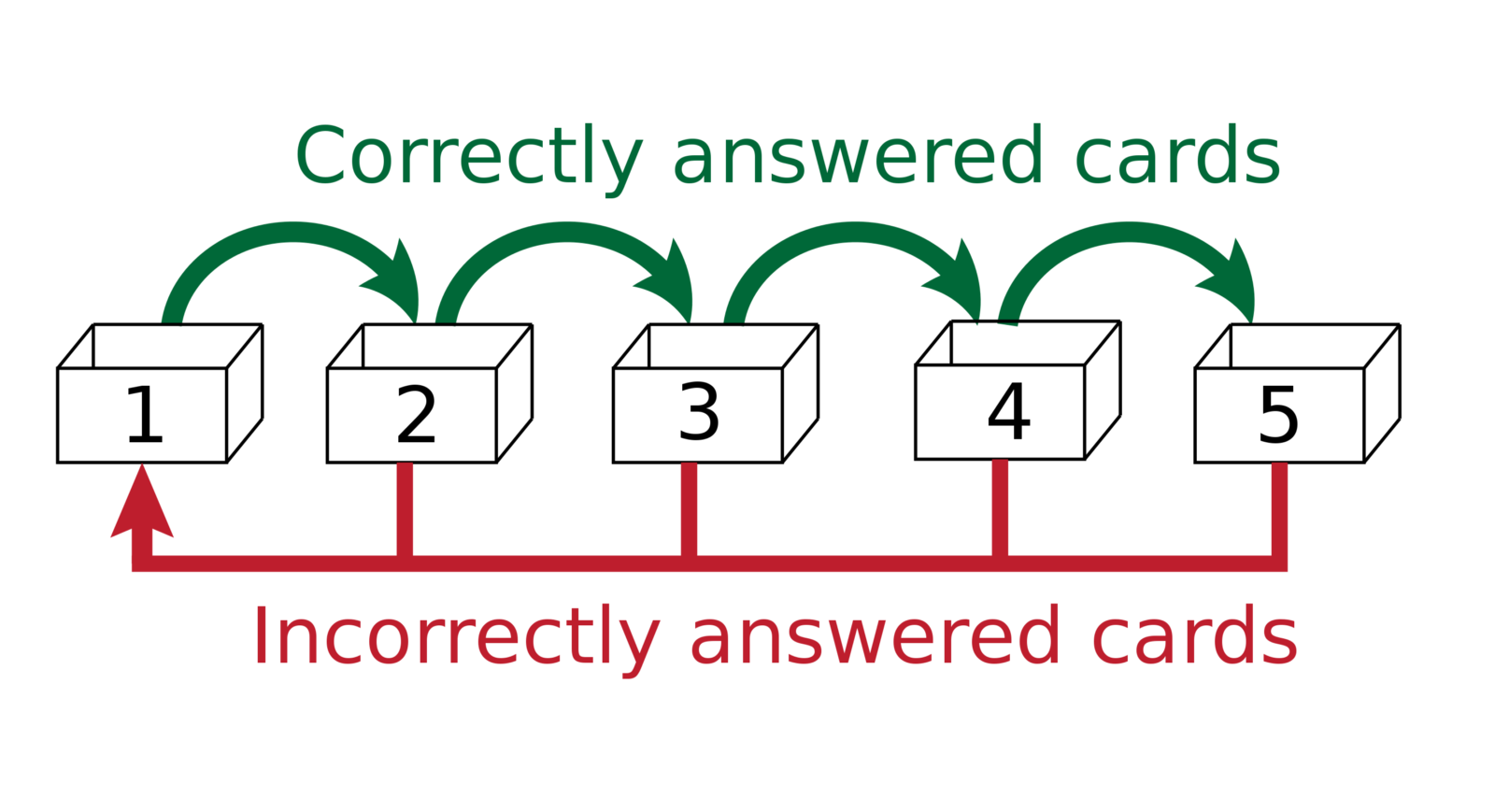
Leinter came up with a great way to use flashcards more effectively: by moving cards between multiple piles/decks. If you answer the question correctly, you’ll encounter the card in a longer interval; if you get it wrong, you’ll see it again soon.
This technique is called Spaced Repetition System, and there are lots of apps available for it - the most famous one being Anki.
For me, the ideal way of studying kanji was the website Reviewing the Kanji. It had everything I needed: kanji cards, the option to write my own mnemonic stories or use stories written by others, plus an SRS system.
I found this method really helpful. I didn’t have much time each day to study Japanese, but I was still able to memorize around 1,000 kanji after two months, and it was actually fun! Eventually, I slowed down at around 2–2k kanji, but to be honest, I could have stopped at 1.2k of the most common kanji - that would have been enough for a beginner.
At the same time, I was checking out this website for some grammar. It was pretty helpful and easy to understand. I stopped at about 2/3 of the content since I had enough grammar but not enough vocab.
For vocabulary, I had two options: learn new words from native content, or use apps/websites/anki decks with pre-made materials. I chose the second ‘cos I didn’t think I could handle reading native stuff without too much pain.
I used this paid resource, and it was totally worth it. It let me study around 6k words (though many say that 2k is enough). It was great for learning vocab, pronunciation, examples of usage, and so on. Plus, it had all the gamification stuff I love - achievements, levels, progress, etc.
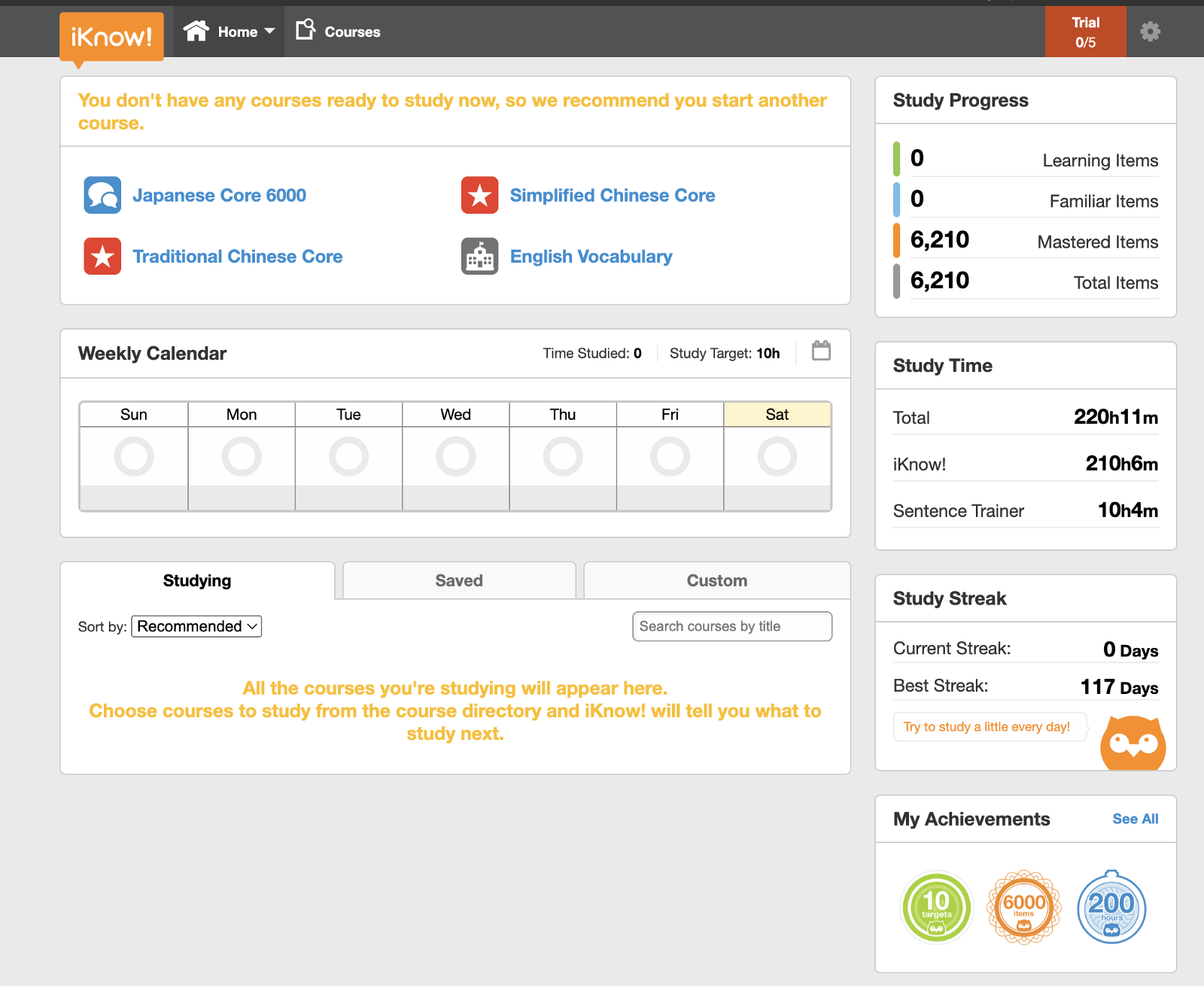
I was learning words off this website and using Anki to help me memorize them (there was a public deck with the same words). I was trying to learn around 50 new words every day because I wanted to finish and then move on to something else.
Each new word I picked up made things a lot easier: it can be tricky to remember how to pronounce the Kanji since most of them have two pronunciations. But with each word I learned, the pronunciation of the Kanji got easier to remember. More words meant more knowledge.
I did this for 2–3 hours every day for a few months. I still remember how I used to study Japanese on the metro with my old laptop. I couldn’t use the wifi, so I’d download the materials beforehand, study on the way, and then refresh my browser.
In April 2013, I finished studying 6k words on Iknow, but I kept going over them in Anki because I only knew half of them really well. Finally, I was able to do some more enjoyable activities like reading tweets, basic manga, and other stuff.
It took a few months, but I didn’t really make much progress. On the one hand, it was hard to find material that was both understandable and fun. On the other hand, I could read song lyrics and some manga and even spot mistakes in translations. It was awesome to be able to read new manga chapters before they were translated. And when I ran into unknown grammar constructions, I’d keep learning new vocab and studying grammar.

In July, I was feeling tired and demotivated, so I decided to take a break and switch to German. I just did reviews on Anki and read some tweets for about an hour each day until October.
But then, I was able to get my motivation back and make some progress. First, I refreshed my grammar knowledge and improved it. To do that, I went through all the lessons on this website in two weeks. There’s a lot of great information about grammar points and lots of examples, plus some interesting cultural notes about Japan. I didn’t use the site’s extra features for kana, kanji, and vocab though, as I prefer to use other resources for that. Oh, and why two weeks? Because there was a free trial for 14 days.
After that, I started using Tae Kim’s grammar guide again. It’s comprehensive, so what more could I ask for? To practice conjugations, I used an Android App (which is dead now). It’s not much, but it does the job of helping me to train my conjugation skills.
I continued following a few Japanese people on Twitter and reading their posts. Plus, I started listening to and reading easy Japanese news. To dive deeper into the language, I changed the language on my browser and tablet to Japanese. To take it a step further, I tried writing in Japanese on lang-8 http://lang-8.com/ and reading more challenging material.

For reading and immersion, I used Rikaisama - an addon for Firefox.
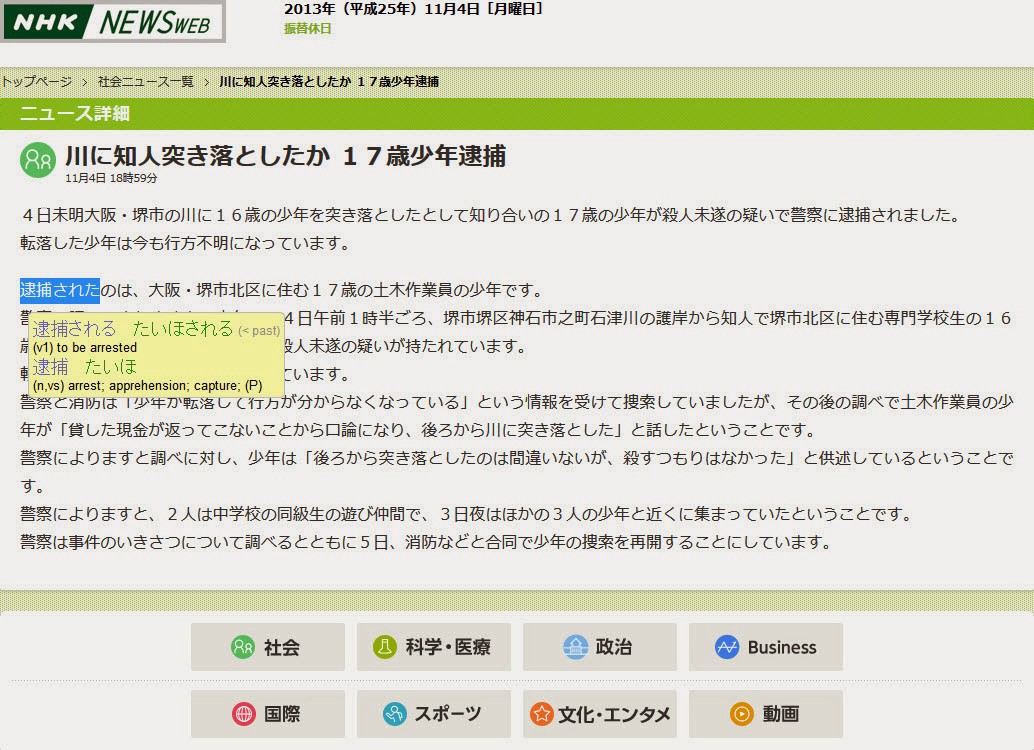
If you’re reading Japanese online and need to know what a word means, Rikaisama is here to help! Simply move your mouse over the word, and a pop-up translation will appear. But that’s not even the best part - you can save the word, reading, meaning, and sentence to a file on your PC with one button and use another to create a card for Anki!
But what about offline? Enter Yomichan: it’s got almost the same functionality as Rikaisama!
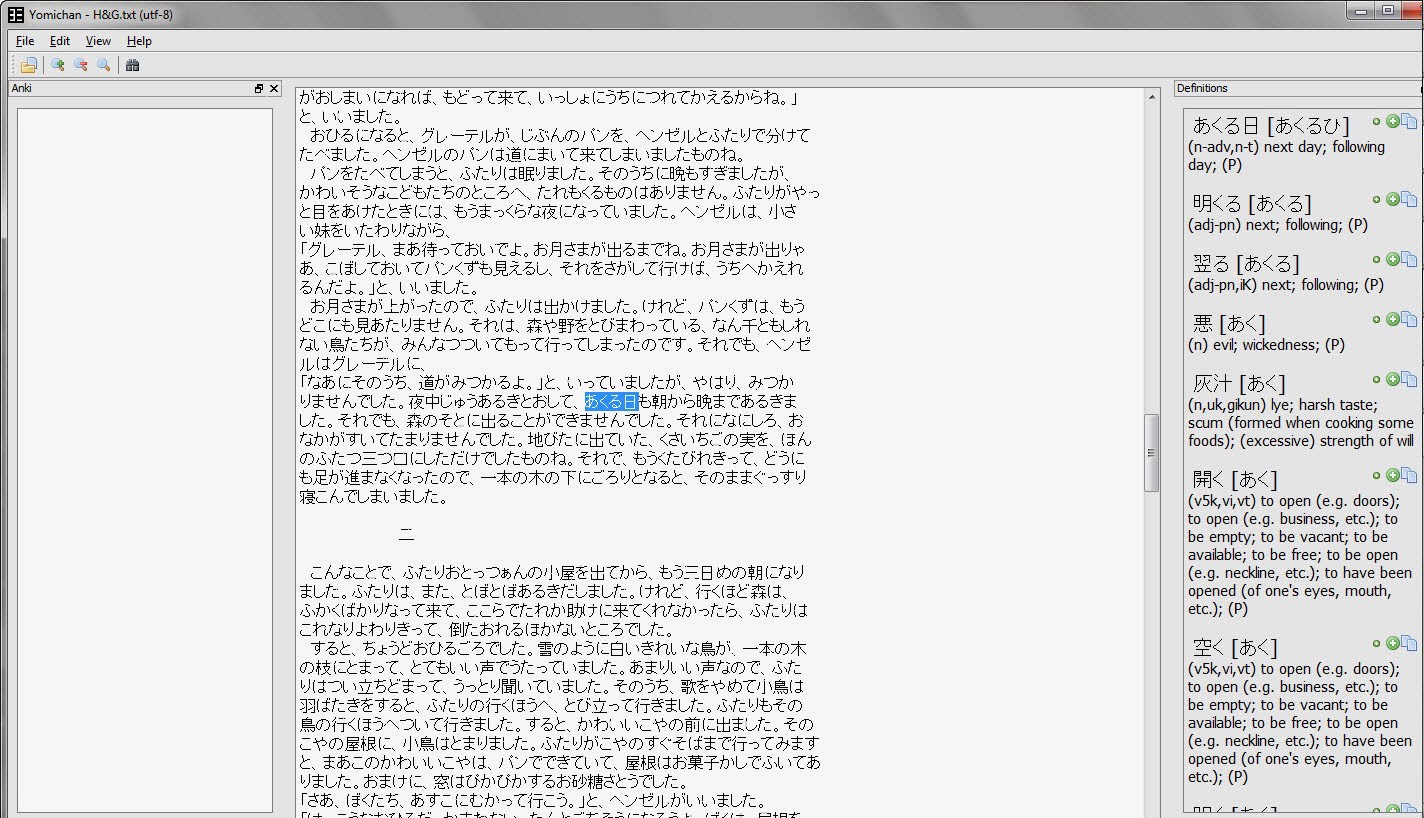
By January 2014, it’s been more than a year since I started learning Japanese in October 2012, and I’ve been spending 2–3 hours a day, and even more on weekends, for a couple of months. I realized I was spending too much time on boring stuff like the news, so I switched to reading visual novels. It was challenging but totally doable.

This was my setup for reading them: a program in the bottom-left corner would capture and recognize new text lines from the visual novel in the top-right corner. The text would then be copied to the clipboard and captured by a program in the top-left corner. This program would show furigana for kanji and use several dictionaries (I had four) to translate the text into English. I’d copy any interesting sentences to a notepad to study later and import them to Anki through Yomichan.
The translation quality would vary - short and simple sentences would be translated fine, but complex ones were too difficult for electronic dictionaries. But I had translations for words, and I just had to use my brain to get the gist of the whole sentence. The texts like this couldn’t be captured, so I’d have to translate them by myself, but it was actually fun:
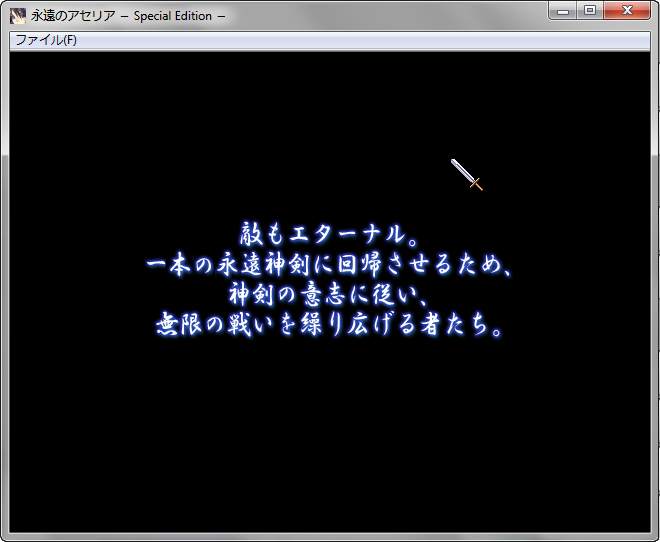
And so I completed my goal of finishing the visual novel in Japanese. But I still had a long way to go.
I read a lot of visual novels over time, one of which was Fate/Stay Niht. To put it into perspective, it is 820,595 words long - much longer than the entire Lord of the Rings series at 576,459 words (including The Hobbit).
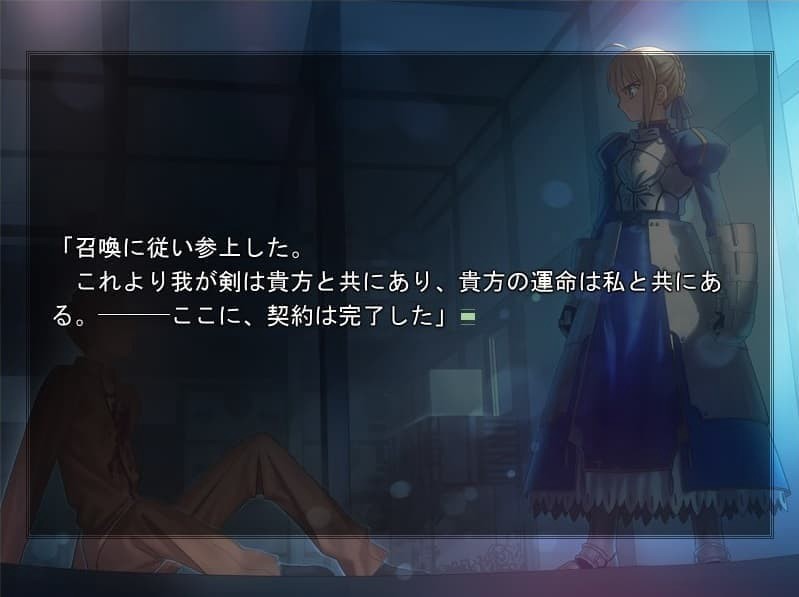
Then I read 魔法使いの夜 (Witch on the Holy Night), a captivating visual novel from the Nasuverse. I was instantly drawn in by its enchanting music, compelling characters, a riveting plot, calming atmosphere, and exquisite art. It follows the story of Aoko Aozaki, a wizard apprentice, her teacher, her sister, and a quiet rural boy who finds themselves in a perilous situation. I spent around 50 hours reading it, and it was totally worth it - it was a truly magical experience that I’ll never forget. Even though I may not read it again, it has left a lasting impression on me, and I’m grateful for it.

After that, I tried three visual novels by Eushully: 創刻のアテリアル, 戦女神 0, and 戦女神VERITA. Gameplay was fun but repetitive and required grinding for full completion. It took ~100–140 hours for the first, ~80 for the second, and ~60 for the third (and I didn’t complete everything in them). Reading visual novels (VNs) also motivated me to work on my grammar. I used the Kanzen Master series, which covers 3kyuu and 2kyuu levels. I had a lot to learn.
VNs are great for studying Japanese. You get a wide range of words and different speech styles based on a character’s social status, and they are voiced, which makes them incredibly helpful. I gained a great deal from them.
In July 2014, I took a test to see how good I was at Japanese, and the result was N3. Not bad, but I was hoping for more. I think the main reason was that I never really prepared for the test - I just learned the basics of grammar and vocabulary and then moved on to whatever I came across. So for a few weeks after the test, I was drilling the grammar I didn’t know because there was a ton of it. I also tried to learn as many words from JLPT sheets as I could.
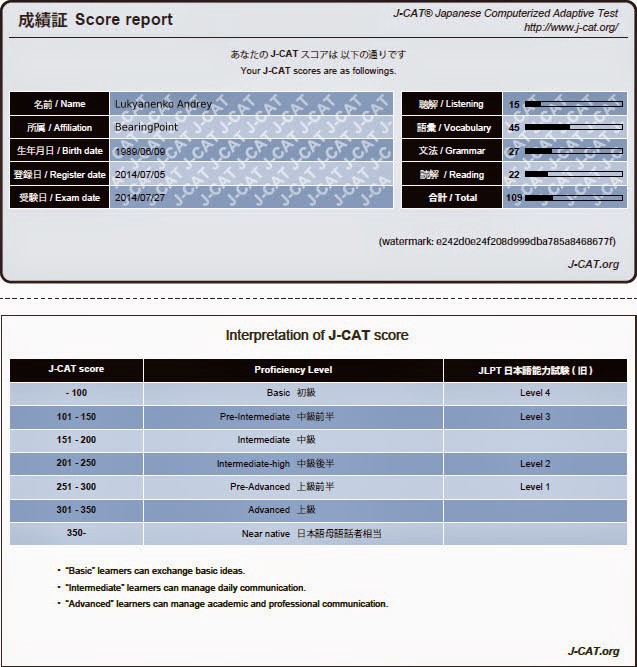
In 2015 I didn’t have as much time to spend on Japanese as I wanted, but I still managed to play a few visual novels - the most memorable being Dies_Irae. It was amazing! It had an epic story with so many different routes and tons of unexpected twists - you never knew who would live and who would die, the main character didn’t always win, etc. Plus, the art was gorgeous, the characters were unforgettable, and the author threw in quotes from all sorts of languages - Goethe’s “Faust”, French phrases, German hunting songs, Latin requiems - the list goes on. I was really captivated by the story and hope to read it again.
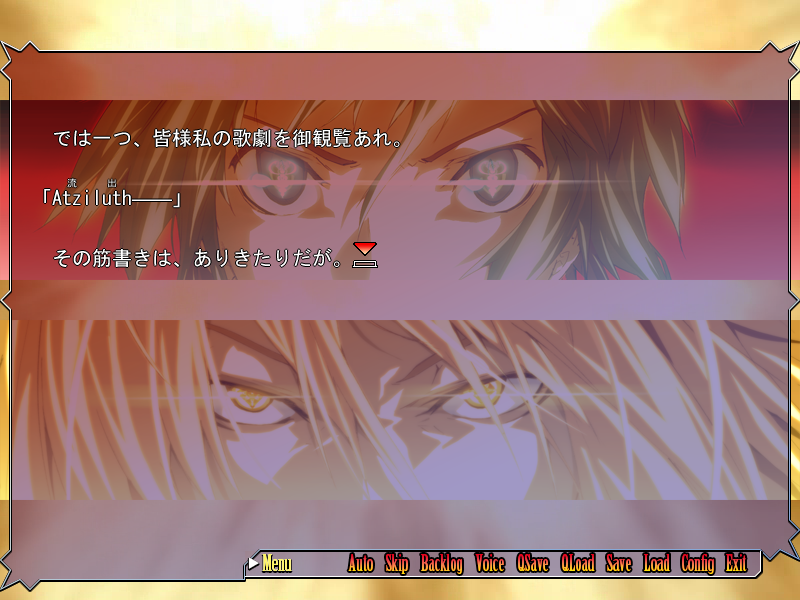

In 2016, I decided to switch my career focus to data science, and as a result, I had to put an end to my study of Japanese. I hope to be able to make up for the lost time in the years to come, and I am determined to get back to studying it in the future.
- Studying Japanese was a challenge but totally worth it;
- Making your own study plan can be tough - it’s easy to make mistakes. It’s a good idea to use guides, but the Japanese learning community can be overwhelming - some of the advice can be pretty extreme;
- If you’re learning solo, you don’t get instant feedback on your mistakes, so they can stick around for a while;
- It took me ages to get Japanese to a usable level, but it was totally worth it in the end;
Spanish
I decided to take a break from studying Japanese and try something new, so I chose to learn Spanish! It’s one of the top three languages in the world, so it’s both interesting and not too tricky to pick up. Plus, Spain has such an amazing culture - there’s so much to explore! Learning a new language is always a great investment in so many ways.
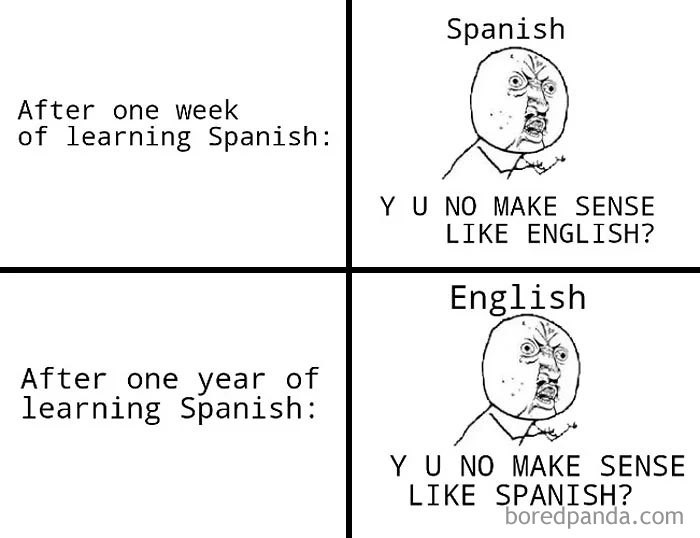
I decided to begin my journey to learn Spanish with two resources. The first one was Duolingo, which is great for beginners and lower/intermediate levels. It provides plenty of exercises that allow you to retain topics and grammar points, as well as pronunciation training and immersion activities. The second was a textbook called “Spanish: An Essential Grammar” similar to the one that helped me a lot when I was studying German.
I was able to complete Duolingo in three weeks. Now, I’ll admit I didn’t memorize everything I went through, but it was still a fun experience. At that time, it was much shorter than it is today.

After that, I tried reading some Spanish news, and, at first, it felt like I was looking at a mysterious text with just a few words that I recognized. But then I tried to focus on understanding it and realized it wasn’t so bad! There were a lot of new words and some grammar I wasn’t sure of, but thanks to the news title, I could get a general idea. Plus, a lot of words could be guessed.
Next, I used the listening-reading approach with Harry Potter and the Philosopher’s Stone and found it was not too hard, so I decided to make it a bit more challenging.
I then found the Spanish text of “La sombra del viento” (The Shadow of the Wind) as well as its English translation and a Spanish audiobook. This novel is a bestseller all over the world, and it was quite long for a beginner language learner - about 300 pages and 19+ hours of audio - but I figured the more, the better! It was tricky at first, but as I read each chapter, I found the process becoming smoother, and I eventually started to enjoy the book.
It was really interesting with its intricate story, memorable characters, and a great ending. Listening to the Spanish audiobook while reading the English text was really helpful as I learned a lot of new words and phrases. Plus, I was able to spot mistakes in the translation - errors in certain phrases, missing sentences, misinterpretations, and other errors.
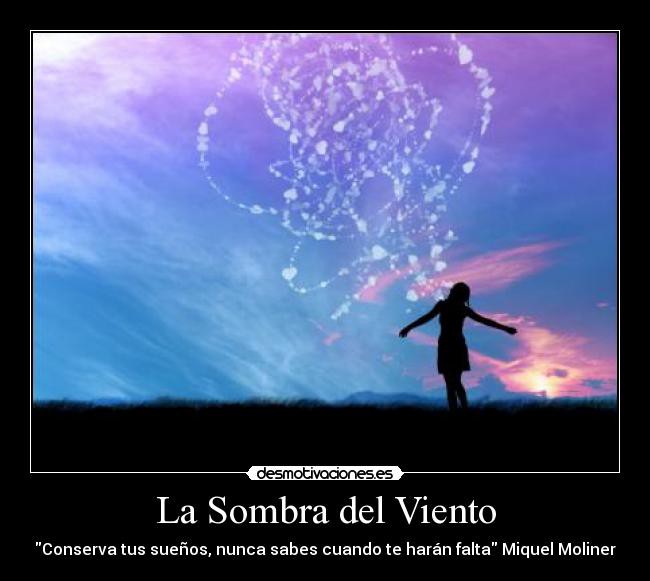
After two months of studying Spanish, I decided that I had built a decent foundation for the language (now I see that I was far from being correct). My grammar and vocabulary were at a level where I could read news articles and gain a moderate understanding. At that point in time, I discovered an amazing free audio course on language transfer which helps you not only to learn a language but to really think in it. It follows the structure of a teacher-student dialogue, beginning with words that are similar in Spanish and English (or, more precisely, from Latin). Then we learn general structures, verb tenses, and more. The course lasts for 14.5 hours and taught me more than several weeks of self-study.
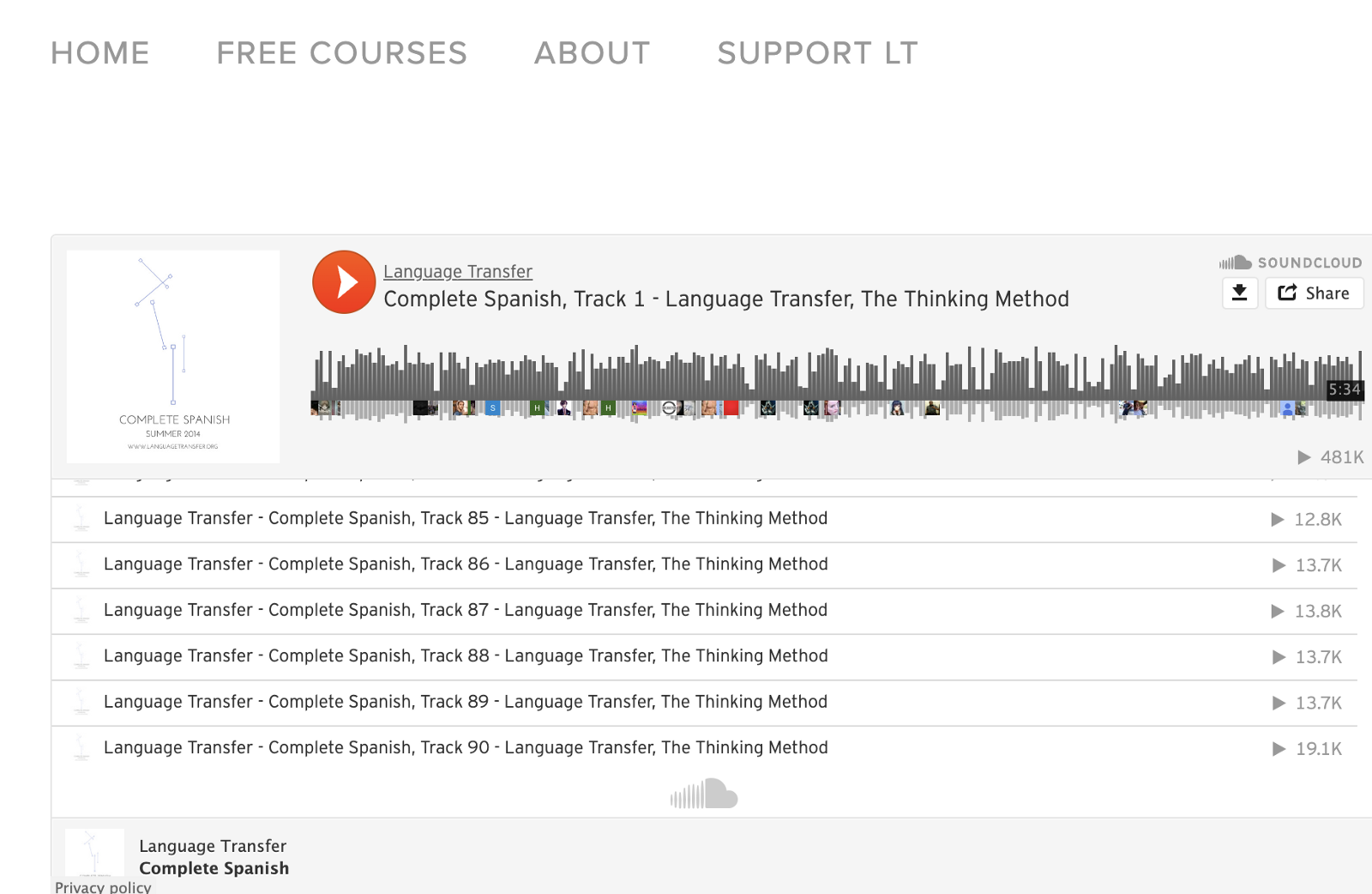
In addition, I remembered that the best way to learn a language is to completely immerse yourself in it - so I changed my phone and browser to Spanish and followed Spanish pages on social media, read in Spanish, and even tried to think in Spanish. This really helped me improve my Spanish! But eventually, I had to take a break from learning Spanish to focus on other things.
In 2022, I decided to resume my Spanish studies. I used Duolingo again, and despite its many faults, it’s still useful for practice. I’m currently at unit 172 and spend ~30 minutes per day to maintain the streak. I listened to the Complete Spanish Course by Language Transfer again and downloaded a few shared Anki decks: one for grammar and the rest for vocabulary. I also practiced conjugations on https://conjuguemos.com/.
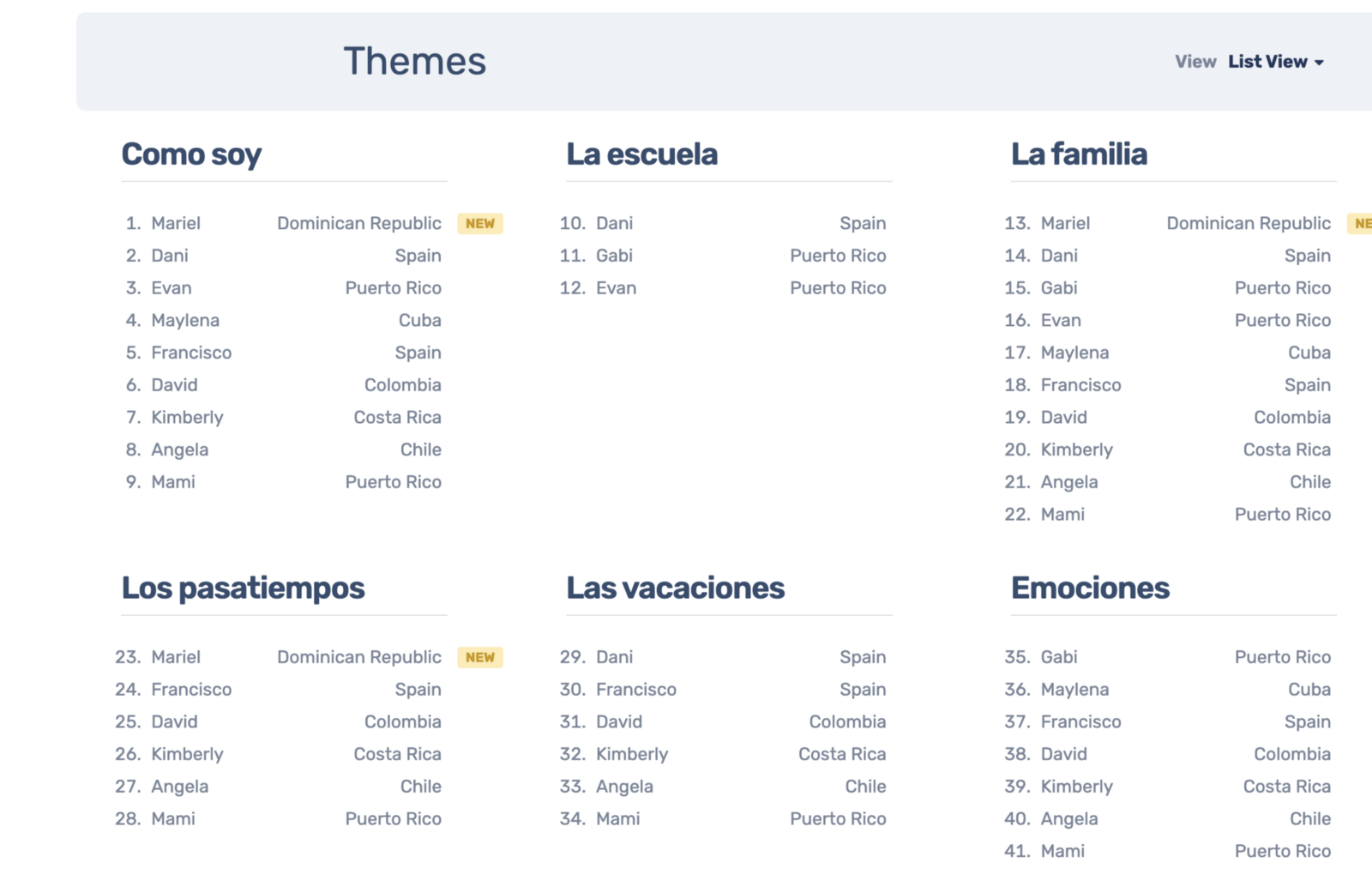
After I completed my drilling exercises, I moved on to the section with native content. At first, it was quite difficult to understand the speech - I understood almost nothing and felt a bit lost and bummed out. So, I made sure to listen to the audio and look at the transcript/translation, and I noticed a big improvement really quickly. By the end, I was able to understand the new audio without looking at the transcripts - though some accents can still be tricky to understand.
I continue creating cards in Anki by myself, but fewer than before.

I spent a few months learning 50–100 new cards in Anki each day. I especially liked this deck since it had audio. This was really helpful for comprehension and production since I was reading or listening to 300–500 sentences each day. In the end, I deleted all the downloaded Anki vocabulary decks except this one because it provided a lot of colloquial phrases. I chose to no longer use the downloaded decks for a few reasons: some of the words were obscure, sometimes it was hard to guess the words from the context, and some cards were just wrong. But the main reason was that I decided to spend less time on Anki and more time on immersion.
Then I recalled the listening-reading method (I had forgotten about it after several years of not studying Spanish). I used this method with the first Harry Potter book, then with Arcanum Ilimitado. Now I’m reading El Camino de los Reyes.
I also played Neverwinter Nights in Spanish for practice and fun.
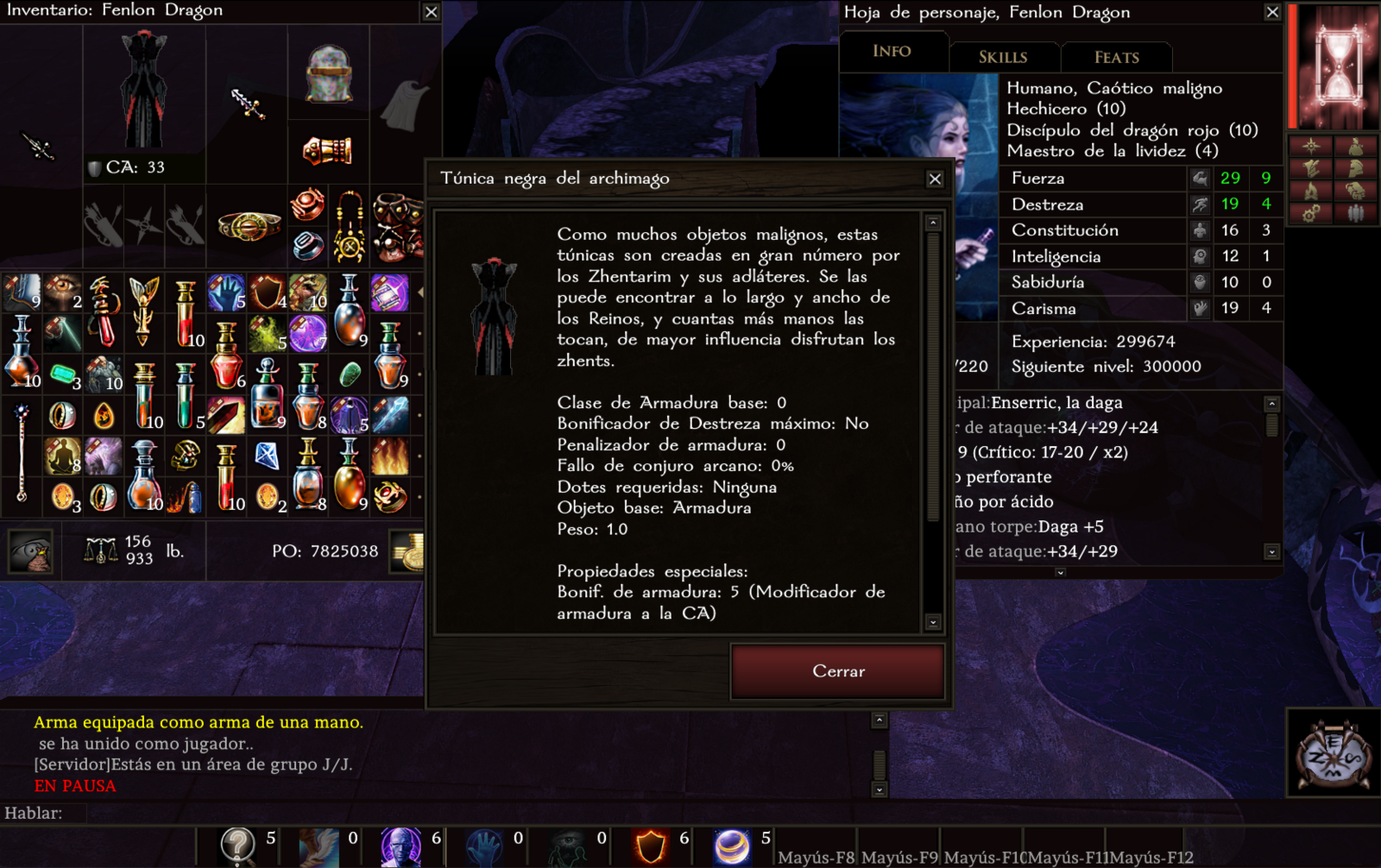
Another awesome tool for reading was Kindle Oasis. In Kindle devices we can tap on a word and see a translation:

Later it is possible to export the whole vocabulary and import it into Anki. There are some tools to do it, but each tool has its own downsides. After some time, I made my own app to do it:

In addition, I decided to practice my Spanish speaking skills, something I hadn’t previously done while learning German and Japanese. My first opportunity to do so came when I met a friend from an online game - a Colombian - and we talked about many things, including language learning. We spoke in Spanish for several minutes, and I was able to express my thoughts about learning languages, habits, and life in general. I made a few mistakes with my verb forms, but my vocabulary was sufficient, and my friend was quite impressed. He told me that my Spanish was already good and would improve with practice.
Afterward, I found a local language-learning community and started attending their meetings. I have the vocabulary to talk about a wide range of topics, but I still need to work on my grammar.
Some time ago I took several online tests to measure my proficiency and got B2:

Learning Spanish was so definitely easier than Japanese and German. One of the main reasons for my success was my previous experience with language learning - I already had a lot of helpful techniques and methods for studying languages, so I was able to use them to my advantage. If I had to do it again, I would definitely spend less time on Anki and Duolingo and more time immersing myself in native content.
General thoughts on language learning
There is no one-size-fits-all approach when it comes to studying languages, as everyone has different preferences and techniques that work best for them. For instance:
- Some people spend hours every day studying, while others only manage to find 15 minutes;
- Some only use textbooks until they’re confident enough to use native materials, while others look to immerse themselves from the get-go and don’t focus on grammar;
- Some people take part in language exchanges, while some prefer to study alone;
- Some get started on writing and speaking from the start, while others focus on getting a lot of input first.
I’m not here to give you “the best” advice; I just wanted to share my own personal experience and what worked for me. And if I were to distill it into one piece of advice, it would be:
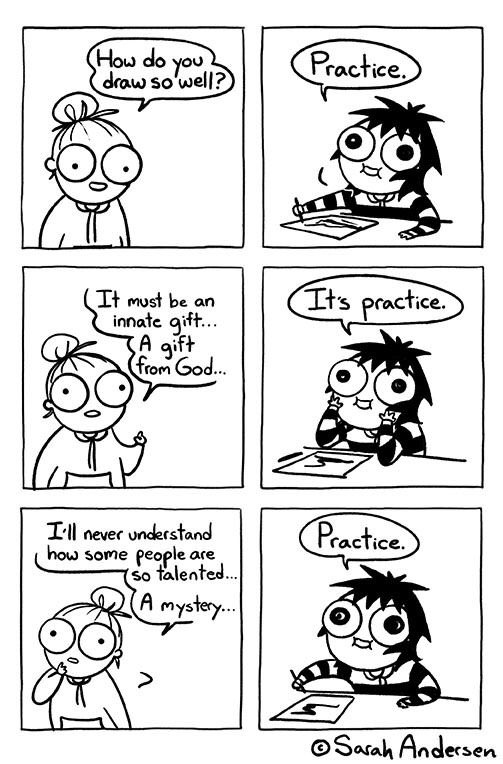
- A great way to go about learning a language is to intermingle studying grammar and vocabulary acquisition. Start by learning the alphabet and pronunciation (which can be tricky for hieroglyphic languages), getting familiar with main grammar concepts, and picking up some vocabulary. When you start feeling overwhelmed by unfamiliar grammar concepts, take a break and focus on studying and practicing them. Focused practice for specific grammar points can really help too;
- Try using immersion with materials just slightly above your level. If it’s too hard, you’ll get frustrated, and if it’s too easy, you won’t learn much;
- Take advantage of helpful tools like Duolingo, spaced repetition tools like Anki, and language acquisition tools like Readlang, Yomichat, and LingQ. But remember that tools are just tools; it’s ok to stop using them when they’re no longer necessary or to use them however you like;
- Balance motivation and discipline. Motivation is about why you want to learn the language: getting a job, moving to a different country, learning the culture, having fun, etc. Discipline is about remembering why and sticking to it;
- Aim to study every day. There are various ways to learn a language and some are more efficient than others, but consistency is the key to success;
- One of the best ways to learn languages is with a private tutor or living in an environment where you can only use your target language - although not everyone can do this;
- Different approaches work at different levels - what works at A0 won’t work at C1, whereas the B2 approach might be unfeasible at the A1 level;
- Make the language part of your life: think in the language, keep a diary, and do your usual activities in your target language if possible;
- Remember that there are no shortcuts to reaching B2 and higher - you need to know the grammar and invest hundreds or thousands of hours in using the language. But it is rewarding;
- Duolingo is great for gamification - it helps to create a habit of studying. But don’t make it your only goal. Your goal isn’t to get 1000 xp on Duolingo. Your goal is to learn the language. Additionally, the further down you go through the courses, the more mistakes you’ll encounter;
- Pre-made Anki decks can be awesome, but they can also have errors. It is better to create Anki decks yourself - this way, you’ll remember words better;
- When you read new texts, don’t try to understand 100% of the words. You don’t need to understand every obscure word - understanding the meaning of the sentence is enough. Even native speakers don’t always understand everything perfectly;
- If you’ve learned a couple of languages, a cool way of improving them is to learn one through the other without using your native language;
- I already wrote about Listening-reading, and now I’d like to dive into more details. When you’re reading in a foreign language and don’t know too many words, it can be uncomfortable because you need to look up so many words. This interrupts the flow and makes it a bit of a hassle. But if you’re reading in a language you know and listening to the foreign language at the same time, you don’t need to look up words - you can immediately see the translation. Plus, you’ll struggle less with grammar. Of course, if the two languages have totally different grammar structures, it might be a bit tricky. But even in that case, you can still “experience” both languages’ grammar at the same time and match them up more easily. You’ll also learn pronunciation. All of this leads to a much faster comprehension speed. The downside is that there’s no real gamification - you won’t get any progress in any app, make cards in an SRS program, and so on. Also, it requires intense concentration;
- If you’re making flashcards with google translate or other translation tools, be sure to double-check the translations - these tools can make mistakes;
- People often say that “children learn languages better than adults” and that “we should just study like children”. Well, it’s true that kids learn languages faster than adults - there’s actually scientific proof of this. Children have these “critical periods” where they’re extra sensitive to certain environmental stimuli. One of these periods, which is between 2 and 6 years old, means they can learn the language much more quickly. Once they hit 6, that neural activity slows down and makes the language harder to learn. So, in terms of time, children have to learn language from the ground up - it might take them 12 years. But for adults, who already know one language, it takes less time to study a second one. However, a child will become bilingual faster if they’re taught both languages at the same time, compared to an adult who learns their native language and then a second language in their adulthood.
AI and language learning
In recent years, machine learning and “magical AI” have become increasingly popular. People have been trying to use it in many different areas, including language learning. As a data scientist, I’d like to share some of my thoughts and ideas on the matter.
- ChatGPT has been a hot topic in the last few months. People have been trying to use it everywhere - in language learning forums and subreddits, people are sharing their examples of its usage. While I think it could be an awesome partner for practicing conversations or for correcting errors, it’s important to be aware that it can make mistakes. ChatGPT is designed to be confident, which means it can confidently give you incorrect information. So, feel free to use it - just remember to be cautious;
- OCR + translation can be a really useful approach for translating manga or any other text from images;
- Creating parallel texts using tools like this one is also a great idea;
- Generating audio based on text is also possible - machine learning or not;
In my opinion, the potential of using machine learning as a tool is huge right now. However, there still aren’t that many solutions that can really help us study languages consistently and without mistakes.
Conclusions
I absolutely love learning foreign languages! Even though it can be a bit challenging at first, I think it’s totally worth it. My language journey has done so much for me: I’ve learned lots of interesting information, English has been incredibly useful for my career, I’ve made new friends, I’ve been able to read things in their original language, and I’ve gained new perspectives.
One of the hardest things about learning languages for me is reaching a level of self-maintenance and incorporating languages into my life. I enjoy acquiring new languages, but the studying process can be quite time-consuming, so I try to reach a good level as quickly as possible and then use either a listening-reading approach or native materials. This makes it even more important to make sure language is part of my everyday life. When you’re embarking on a language journey, it’s a smart idea to think in advance about how you’re going to make it part of your daily routine.
And, finally, here’s a fun fact: there are some drawbacks to learning multiple languages. In the last few years, I’ve read only a handful of books in Russian but hundreds in English. As a result, I sometimes find it easier to express myself in English than in Russian, and I catch myself mixing languages together. Well, nothing can be done about it. Я просто will continue estudiar y ich werde hoffen dass 自業自得.
blogpost life languages